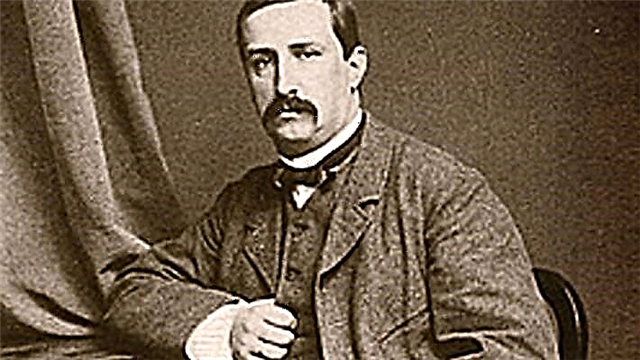Already in ancient times, people understood the importance of blood for human life, even if they did not know what functions it performs. Since time immemorial, blood has been sacred in all major beliefs and religions and in virtually all human communities.
The fluid connective tissue of the human body - this is how doctors classify blood - and its functions have been too complex for science for thousands of years. Suffice it to say that even in the Middle Ages, scientists and physicians in theories about blood did not depart from the ancient Greek and Roman postulates about the one-sided flow of blood from the heart to the extremities. Before the sensational experience of William Harvey, who calculated that if this theory is followed, the body should produce 250 liters of blood per day, everyone was convinced that blood evaporates through the fingers and is constantly synthesized in the liver.
However, it is also impossible to say that modern science knows everything about blood. If with the development of medicine it became possible to create artificial organs of varying degrees of success, then with blood such a question is not even visible on the horizon. Although the composition of blood is not so complicated from the point of view of chemistry, the creation of its artificial analogue seems to be a matter of a very distant future. And the more it becomes known about blood, the clearer it is that this liquid is very difficult.

1. In terms of its density, blood is extremely close to water. Blood density ranges from 1.029 in women and 1.062 in men. The viscosity of blood is about 5 times that of water. This property is influenced by both the viscosity of the plasma (approximately 2 times the viscosity of water), and the presence of a unique protein in the blood - fibrinogen. An increase in blood viscosity is an extremely unfavorable sign and may indicate coronary artery disease or stroke.
2. Due to the continuous work of the heart, it may seem that all the blood in the human body (from 4.5 to 6 liters) is in constant motion. This is very far from the truth. Only about a fifth of all blood moves continuously - the volume that is in the vessels of the lungs and other organs, including the brain. The rest of the blood is in the kidneys and muscles (25% each), 15% in the intestinal vessels, 10% in the liver, and 4-5% directly in the heart, and moves in a different rhythm.
3. The love of various healers for bloodletting, which was ridiculed a thousand times in world literature, actually has a sufficiently deep substantiation for the knowledge available at that time. Ever since the time of Hippocrates, it was believed that there are four fluids in the human body: mucus, black bile, yellow bile and blood. The state of the body depends on the balance of these fluids. Excess blood causes disease. Therefore, if the patient feels unwell, he needs to immediately bleed, and only then proceed to a deeper study. And in many cases it worked - only wealthy people could use the services of doctors. Their health problems were often caused precisely by an excess of high-calorie food and an almost immobile lifestyle. Bloodletting helped obese people recover. It was worse with not very obese and mobile. For example, George Washington, who was suffering from just a sore throat, was killed by copious bloodletting.
4. Until 1628, the human circulatory system seemed simple and understandable. Blood is synthesized in the liver and transported through the veins to the internal organs and limbs, from where it evaporates. Even the discovery of venous valves did not shake this system - the presence of valves was explained by the need to slow down the blood flow. Englishman William Harvey was the first to prove that blood in the human body moves in a circle formed by veins and arteries. However, Harvey could not explain how the blood gets from the arteries to the veins.
5. At the first meeting of Sherlock Holmes and Dr. Watson in the novel by Arthur Conan-Doyle "Study in crimson tones", the detective proudly announces to his new acquaintance that he has discovered a reagent that can accurately determine the presence of hemoglobin, and, therefore, blood, even in the smallest speck. It is no secret that in the 19th century, many writers acted as popularizers of the achievements of science, acquainting readers with new discoveries. However, this does not apply to the case of Conan Doyle and Sherlock Holmes. A Study in Scarlet Tones was published in 1887, and the story takes place in 1881. The very first study, which described a method for determining the presence of blood, was published only in 1893, and even in Austria-Hungary. Conan Doyle was at least 6 years ahead of scientific discovery.

6. Saddam Hussein, as the ruler of Iraq, donated blood for two years to make a handwritten copy of the Koran. The copy was successfully made and kept in the basement of a purpose-built mosque. After the overthrow and execution of Saddam, it turned out that the new Iraqi authorities faced an insoluble problem. In Islam, blood is considered unclean, and to write the Koran with it is haram, a sin. But it is also haram to destroy the Qur'an. Deciding what to do with the Bloody Quran has been postponed until better times.
7. The personal physician of King Louis XIV of France Jean-Baptiste Denis was very interested in the possibility of supplementing the volume of blood in the human body. In 1667, an inquisitive doctor poured about 350 ml of sheep's blood into a teenager. The young body coped with the allergic reaction, and encouraged by Denis, he made a second transfusion. This time, he poured sheep's blood to a worker who had been injured while working in the palace. And this worker survived. Then Denis decided to earn extra money from wealthy patients and switched to the apparently noble blood of calves. Alas, Baron Gustave Bonde died after the second transfusion, and Antoine Maurois after the third. In fairness, it is worth mentioning that the latter would not have survived even after a blood transfusion in a modern clinic - his wife purposefully poisoned her crazy husband with arsenic for more than a year. The cunning wife tried to blame Denis for the death of her husband. The doctor managed to justify himself, but the resonance was too great. Blood transfusions were banned in France. The ban was lifted only after 235 years.
8. The Nobel Prize for the discovery of human blood groups was received in 1930 by Karl Landsteiner. The discovery, which may have saved the most lives in the history of mankind, he made at the beginning of the century, and with a minimal amount of materials for research. The Austrian took blood from only 5 people, including himself. This was enough to open three blood groups. Landsteiner never made it to the fourth group, although he expanded the research base to 20 people. It's not about his carelessness. The work of a scientist was treated as science for the sake of science - no one could then see the prospects of discovery. And Landsteiner came from a poor family and was very dependent on the authorities, who distributed positions and salaries. Therefore, he did not insist too much on the importance of his discovery. Fortunately, the award still found its hero.
9. The fact that there are four blood groups was the first to establish the Czech Jan Jansky. Doctors still use its classification - I, II, III and IV groups. But Yansky was interested in blood only from the point of view of mental illness - he was a major psychiatrist. And in the case of blood, Yansky behaved like a narrow specialist from the aphorism of Kozma Prutkov. Not finding a relationship between blood groups and mental disorders, he conscientiously formalized his negative result in the form of a short work, and forgot about it. Only in 1930, Jansky's heirs managed to confirm his priority in the discovery of blood groups, at least in the United States.
10. A unique method of recognizing blood was developed at the beginning of the 19th century by the French scientist Jean-Pierre Barruel. By accidentally throwing a clot of bovine blood into sulfuric acid, he heard the smell of beef. Examining human blood in the same way, Barruel heard the smell of male sweat. Gradually, he came to the conclusion that the blood of different people smells differently when treated with sulfuric acid. Barruel was a serious, respected scientist. He was often involved in litigation as an expert, and then an almost new specialty appeared - a person literally had a nose for evidence! The first victim of the new method was the butcher Pierre-Augustin Bellan, who was accused of the death of his young wife. The main evidence against him was blood on his clothes. Bellan said that the blood was pig's and got on his clothes at work. Barruel sprayed acid on his clothes, sniffed, and loudly declared that the blood belonged to a woman. Bellan went to the scaffold, and Barruel demonstrated his ability to detect blood by scent in courts for several more years. The exact number of people wrongly convicted by the “Barruel Method” remains unknown.
11. Hemophilia - a disease associated with blood clotting disorders, which only men get sick, getting the disease from mothers-carriers - is not the most common genetic disease. In terms of the frequency of cases per 10,000 newborn babies, it ranks at the end of the first ten. The royal families of Great Britain and Russia have provided fame for this blood disease. Queen Victoria, who ruled Great Britain for 63 years, was the carrier of the hemophilia gene. Hemophilia in the family began with her, before that cases were not recorded. Through daughter Alice and granddaughter Alice, better known in Russia as Empress Alexandra Feodorovna, hemophilia was passed on to the heir to the Russian throne, Tsarevich Alexei. The boy's illness manifested itself already in early childhood. She left a serious imprint not only on family life, but also on a number of decisions of a state scale adopted by Emperor Nicholas II. It is with the illness of the heir that the approach to the family of Grigory Rasputin is associated, which turned the highest circles of the Russian Empire against Nicholas.

12. In 1950, 14-year-old Australian James Harrison underwent a serious operation. During his recovery, he received 13 liters of donated blood. After three months on the brink of life and death, James promised himself that after reaching the age of 18 - the legal age for donation in Australia - he will donate blood as often as possible. It turned out that Harrison's blood contains a unique antigen that prevents the conflict between the mother's Rh-negative blood and the Rh-positive blood of the conceived child. Harrison donated blood every three weeks for decades. The serum derived from his blood has saved the lives of millions of babies. When he donated blood for the last time at the age of 81, the nurses tied balloons with numbers “1”, “1”, “7”, “3” to his couch - Harrison donated 1773 times.
13. The Hungarian Countess Elizabeth Bathory (1560-1614) went down in history as the Bloody Countess who killed virgins and took baths in their blood. She has entered the Guinness Book of Records as the serial killer with the most casualties. Officially, 80 murders of young girls are considered proven, although the number 650 got into the book of records - allegedly so many names were in a special register kept by the countess. At the trial, which found the Countess and her servants guilty of torture and murder, there was no talk of bloody baths - Bathory was charged only with torture and murder. Baths of blood appeared in the story of the Bloody Countess much later, when her story was fictionalized. The Countess ruled Transylvania, and there, as any reader of mass literature knows, vampirism and other bloody entertainments cannot be avoided.
14. In Japan, they pay the most serious attention to a person's blood group, not only with a possible transfusion. The question "What is your blood type?" sounds at almost every job interview. Of course, the “Blood type” column is among the mandatory ones when registering in the Japanese localization of Facebook. Books, TV shows, newspaper and magazine pages are devoted to the influence of the blood group on a person. Blood type is an obligatory item in the profiles of numerous dating agencies. Many consumer products - beverages, chewing gum, bath salts, and even condoms - are marketed and marketed to target people with a particular blood type. This is not a newfangled trend - already in the 1930s in the Japanese army, elite units were formed from men with the same blood group. And after the victory of the women's football team at the Beijing Olympics, differentiation of training loads depending on the blood groups of football players was named as one of the main factors of success.
15. The German company "Bayer" twice got involved in major scandals with drugs for blood. In 1983, a high-profile investigation showed that the American division of the company produced drugs that promote blood clotting (simply, from hemophilia) from the blood of people belonging, as they would now say, to "risk groups." Moreover, the blood from homeless people, drug addicts, prisoners, etc. was taken quite deliberately - it came out cheaper. It turned out that along with the drugs Bayer's American daughter spread hepatitis C, but that was not so bad. The hysteria about HIV / AIDS has just begun in the world, and now it has become almost a disaster. The company was flooded with claims for hundreds of millions of dollars, and it lost a significant portion of the American market. But the lesson did not go for the future. Already at the end of the twentieth century, it became clear that the massively prescribed anti-cholesterol drug Baykol, produced by the company, can lead to muscle necrosis, kidney failure and death. The drug was immediately withdrawn. Bayer again received many lawsuits, paid again, but the company resisted this time, although there were offers to sell the pharmaceutical division.
16. Not the most advertised fact - during the Great Patriotic War, the blood of soldiers who had already died from wounds was massively used in hospitals. The so-called cadaver blood has saved tens of thousands of lives. Only to the Institute of Emergency Medicine. Sklifosovsky during the war, 2,000 liters of cadaver blood were brought in every day. It all began in 1928, when the most talented doctor and surgeon Sergei Yudin decided to transfuse the blood of an old man who had just died to a young man who had cut his veins. The transfusion was successful, however, Yudin almost thundered into prison - he did not test the transfused blood for syphilis. Everything worked out, and the practice of cadaver blood transfusion entered surgery and traumatology.
17. There is practically no blood in the Blood Bank, there is only one that was recently delivered for separation. This blood (contained in thick-walled plastic bags) is placed in a centrifuge. Under enormous overloads, the blood is divided into components: plasma, erythrocytes, leukocytes and platelets. Then the components are separated, disinfected and sent for storage. Whole blood transfusion is now used only in case of large-scale disasters or terrorist attacks.
18. Those who are interested in sports have probably heard of a terrible doping called erythropoietin, or EPO for short. Because of it, hundreds of athletes suffered and lost their awards, so it might seem that erythropoietin is the product of some top-secret laboratories, created for the sake of gold medals and prize money. In fact, EPO is a natural hormone in the human body. It is secreted by the kidneys at a time when the oxygen content in the blood decreases, that is, mainly during physical exertion or a lack of oxygen in the inhaled air (at high altitudes, for example).After rather complex, but fast processes in the blood, the number of red blood cells increases, a unit of blood volume becomes able to carry more oxygen, and the body copes with the load. Erythropoietin does not harm the body. Moreover, it is artificially injected into the body in a number of serious diseases, from anemia to cancer. the half-life of EPO in the blood is less than 5 hours, that is, within a day the amount of the hormone will be vanishingly small. In athletes who were “caught” taking erythropoietin after a few months, in fact, it was not EPO that was detected, but substances that, in the opinion of anti-doping fighters, could hide traces of the hormone — diuretics, etc.

19. “White Blood” is a German film about an officer whose spacesuit tore during a nuclear test. As a result, the officer received radiation sickness and slowly dies (there is no happy ending). The blood was truly white in a patient who applied to a hospital in Cologne in 2019. There was too much fat in his crvi. The blood purifier clogged, and then the doctors simply drained most of the patient's blood and replaced it with donor blood. The expression “black blood” in the meaning of “slander, slander” was used by Mikhail Lermontov in his poem “To the death of a poet”: “You will needlessly resort to slander / It will not help you again. / And you will not wash away all your black blood / of the Poet's righteous blood. " "Black Blood" is also a fairly well-known fantasy novel by Nick Perumov and Svyatoslav Loginov. The blood becomes green if a person has sulfhemoglobinemia, a disease in which the structure and color of hemoglobin changes. During the revolutions, the aristocrats were called “blue blood”. Bluish veins showed through their delicate skin, giving the impression that blue blood was running through them. However, the deceitfulness of such notions was proven back in the years of the Great French Revolution.
20. In Europe, not only just killed giraffes are butchered in front of children. In The Amazing World of Blood, which was filmed by the BBC in 2015, its host Michael Mosley not only provided a lot of really interesting details about blood and the work of the human circulatory system. One of the fragments of the film was devoted to cooking. Mosley first informs the audience that dishes made from animal blood are present in the kitchens of so many peoples of the world. Then he prepared what he called "blood pudding" from ... his own blood. After trying it, Mosley decided that the dish he had prepared was interesting to the taste, but somewhat viscous.









